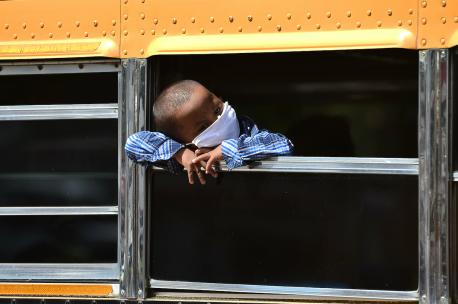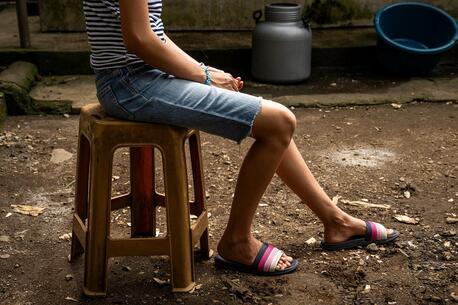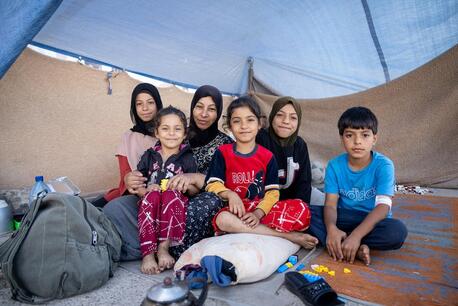
Protecting Child Migrants During a Pandemic
How UNICEF is ensuring appropriate care and protection for children on the move in northern Central America, Mexico and the U.S. in the context of COVID-19.
For years, families and children desperate to escape the gang violence and extreme poverty that plague countries like Guatemala, El Salvador and Honduras have been heading north along the Central America-Mexico-U.S. migration route.
And wherever they are, UNICEF is there every step of the way, working to protect their rights and keep them safe from harm.
COVID-19 hasn't stopped migration flows, but it has heightened the risks and complicated matters both for those making these dangerous journeys north and those employing humanitarian response efforts. For its part, UNICEF has deployed a multi-pronged strategy in the region to strengthen child protection systems and meet the immediate needs of the most vulnerable.
According to UNICEF, 75% of the migrant population crossing into Mexico are migrants traveling with at least one child, and many are detained or deported back to their countries of origin without being given the proper chance to seek safety.
This trend has only intensified during the pandemic. Children on the move have become even easier targets for trafficking and other forms of exploitation while international protections have weakened, partly due to policy changes adopted by governments in the region as part of their COVID-19 response.
Ripple effects of the COVID response for migrants across the region
Countries of transit — countries that are located along the migratory route but are not the intended destination — are seeing greater numbers of migrant children in need of protection as borders close in an effort to contain the spread of COVID, ultimately extending their stays in shelters or makeshift camps.

Janet, 13, (front left) and family members crossed the Tuquesa River to reach Bajo Chiquito, the first Panamanian village by the Colombian border, after a 7-day journey across the Darién Gap. Migrants describe the passage as the most dangerous and difficult stage of their journey to North America. © UNICEF/UNI308591/Urdaneta
Meanwhile, increasing numbers of migrant children and families are stuck in limbo in Mexico. In 2019, an estimated 60,000 to 80,000 migrants lived in overcrowded shelters or informal tent encampments along the U.S.-Mexico border while waiting for their asylum hearings in U.S. courts. In mid-March 2020, U.S. policy changes halted asylum processing indefinitely.
Since then, over 8,700 unaccompanied migrant children have been turned away from the U.S. border and forcibly returned to Mexico and Central America — the majority without adequate protection or heath safeguards and without consideration of the child’s best interests.
Children who are returned to their countries of origin often face community stigmatization, social exclusion and internal displacement, in addition to the violence and extreme poverty they were trying to escape in the first place. And countries of origin — already under tremendous strain in attempting to meet the protection, social service and broader needs of children from their own marginalized communities — are faced with the task of supporting not just those returned but other migrants whose passage through had stalled.

A mother and children at home in Guatemala, where gang-related violence and other threats made it dangerous to go to school even before COVID-19. © UNICEF/UNI328535/Volpe
There are other vulnerabilities. Quarantine restrictions have increased the risk of domestic violence and sexual abuse against women and children, especially for those living full-time with their abusers. Child protection systems in a number of countries in the region — already struggling to reach children in need before the pandemic — have become even more compromised.
And then there are the health risks posed by COVID-19 itself. For asylum-seeking children and families staying in crowded shelters or immigration detention facilities, it is difficult if not impossible to practice even basic prevention measures such as social distancing, and masks and other critical personal hygiene supplies are simply not available.
Shelters run by non-governmental organizations (NGOs) — often the sole providers of care and services to migrant children — are rapidly closing, due to an inability to ensure COVID-19 prevention measures or a lack of resources to continue operations. Health systems in many cases are unable to reach these shelters with testing and follow-up services.
Key pillar of UNICEF’s response: strengthening child protection systems
UNICEF is working with municipal governments, community leaders, youth-led organizations and child protection authorities across the region to strengthen their capacity to respond to violence and improve child protection services. These efforts also include developing guidelines and protocols which ensure rights-based interventions centered around the best interest of the child, and monitoring the provision of care and child protection services by state authorities.
“Even prior to the pandemic, child protection authorities in Mexico were functioning with less than one-third of the budget required to operate effectively,” Dora Giusti, UNICEF México's Child Protection Chief, points out. “With the pandemic, child protection agencies are increasingly understaffed. Social workers do not have proper protective equipment. As a result, children and youth are not receiving the consistent attention and care that they need.”
In Guatemala and Mexico, UNICEF has worked with national governments to draft, formalize and implement the formal legal procedures that guide the child protection systems, ensuring care for migrant children.
“In Mexico, we have been building the capacity of child protection authorities to make placement decisions for unaccompanied children based on formal best interest determination procedures (rather than expediency or immigration enforcement) and supporting child protection authorities on strong case management practices,” Giusti says. “This includes helping children access social, health and mental health services.”
In Honduras, UNICEF has been focusing its interventions in 25 neighborhoods in San Pedro Sula and Choloma — two cities with some of the highest rates of crime and homicide. Over a dozen community leaders were selected to be Violence Interrupters, who are trained to implement violence reduction actions and mediation, explains Lea Beaudry, UNICEF Child Protection Specialist in Honduras.
“This evidence-based approach promotes resilience by working with local actors to identify risk factors, mediate conflicts, engage adolescents and youth, support parents with positive parenting approaches, and carry out case management with adolescents, especially those at risk of falling prey to criminality and/or recruitment into street gangs,” Beaudry says. “This includes getting them connected to counseling, psychosocial support and protection services, education and livelihood programs.”
Some key violence interruption strategies include:
- Deescalating intimate violence against women and girls, including attempts at sexual abuse
- Negotiating safe passage for students between rapidly changing gang-controlled territories
- Mediating between gangs to prevent shootings and avoid reprisals
- Negotiating with gangs to avoid forced recruitment of boys, girls and adolescents
- Organizing public events such as movie nights, live plays, concerts and sports tournaments to reclaim public spaces (to resume when COVID restrictions on gatherings lift)
These community-based interventions have not stopped with the pandemic. During the month of April, for example, interrupters successfully mediated in 83 violent incidents involving 348 people. “These local strategies are crucial if we want to reduce the all too high rates of violence against girls, boys and teenagers” Beaudry says.
(Read more about how UNICEF is working to safely reintegrate migrants returned to Honduras.)
Other child protection priorities include working with local and government partners to develop family- and community-based alternatives to detention — a top UNICEF priority that has taken on greater urgency in the context of COVID-19.
In Mexico, the federal government made a commitment to ending child immigration detention, but it is still common practice. As Giusti explains, this is due to a long-standing institutional culture of border control over protection, discrimination and lack of alternative care options for children who travel alone. This makes UNICEF's work piloting alternatives to detention all the more urgent.
Detention of children on the move often occurs in facilities that are called something other than detention, such as the "migration centers" in Mexico, where small children are held with their mothers. If the children are teenagers, they are usually transferred to a separate area. And the tendency has been to run a “closed-door” program — meaning that children are not allowed to go outside. Workshops, schooling (if available), therapy and play are all offered inside, but with limited capacity.
This model of care increases the levels of anxiety and frustration in children, who are also carrying the scars of separation, of their difficult journeys, and experiences with violence at home.
UNICEF has developed models of care in collaboration with local authorities to make alternative options such as open-door shelters, foster care and independent living more accessible. This includes the establishment of Mexico's first two open-door reception centers in the states of Tabasco and Sonora. Similar plans are under way in Chihuahua, where UNICEF is also developing the country's first family foster care program.
Another key component of UNICEF's response: mental health and psychosocial support
UNICEF is also working to connect social workers and psychologists with children on the move in communities along the migratory route — communities with high rates of violence, those located at border points, those with consular offices and detention centers and others affected by migration. Support includes direct services as well as building the capacity of organizational staff working with children at transit shelters.
Through Guatemala’s consular offices, UNICEF has also supported psychologists, embedding mental health interventions at pivotal points along the journey, including detention centers in Mexico and in the U.S.
“Since the pandemic, we have adapted and found ways to provide this support remotely,” Giusti says. “We have been hosting virtual mental health and psychosocial interventions for children and caregivers in border shelters, using play and sports, building resilience, life skills and coping mechanisms.”
UNICEF is also providing frontline workers and volunteers with remote training on psychological first aid for migrant children and families.
The importance of Child-Friendly Spaces
Providing children with a safe space to engage in sports, arts and other recreational activities has been found to help heal wounds, strengthen coping mechanisms and build resilience among children who have experienced trauma.

UNICEF's strategy for providing mental health and psychosocial support to migrant children includes creating safe spaces for children to learn and play. © UNICEF México/Verdeespina/
In 2019, Child-Friendly Spaces and sports activities implemented by UNICEF and partners benefited more than 19,000 children on the move from El Salvador, Guatemala and Honduras among other countries. In 2020, UNICEF has helped create Child-Friendly Spaces and supported psychosocial support interventions in the camps and shelters in cities such as Matamoros, which is one of the most dangerous border ports in northeastern Mexico. The activities have helped reduce levels of aggression, fights, anxiety and stress among children, according to UNICEF’s own monitoring staff and parents, caregivers and local authorities observing the situation.
During COVID-19, these spaces were replaced by online activities screened at the shelters. Individual and group counseling sessions also moved online.
Stricter immigration controls will not keep people from seeking safety or better opportunities in other countries. They will just make these journeys more treacherous.
As travel restrictions ease in the northern countries of Central America, and the social and economic impacts of the pandemic worsen, UNICEF expects the number of migrant children to increase.
“We are already seeing an increase in families in dire economic circumstances looking for institutions who can take care of their children, which is a grave concern for UNICEF,” says Monica Darer, Child Protection Specialist for the UNICEF Latin America and the Caribbean Regional Office. “We are also seeing an increase in family-based violence. Organized crime will not disappear, but assert greater control in places where the state has left a vacuum. And stricter immigration controls will not keep people from seeking safety or better opportunities in other countries. They will just make these journeys more treacherous.”
Beaudry agrees. “We do not expect migration to stop because of policy restrictions. Instead, they push people to seek protection along more dangerous routes," she says. “Until the root causes of migration are addressed, children and families in the region will continue to migrate.”
Learn more about UNICEF's Agenda for Action for Child Migrants in Central America, Mexico and the U.S.
Top photo: A boy from the Miskito ethnic group in Honduras leaves Tegucigalpa for his home community of La Mosquitia after his parents lose their jobs due to the COVID-19 pandemic. © UNICEF/UNI364606/Sierra/AFP
HOW TO HELP
There are many ways to make a difference
War, famine, poverty, natural disasters — threats to the world's children keep coming. But UNICEF won't stop working to keep children healthy and safe.
UNICEF works in over 190 countries and territories — more places than any other children's organization. UNICEF has the world's largest humanitarian warehouse and, when disaster strikes, can get supplies almost anywhere within 72 hours. Constantly innovating, always advocating for a better world for children, UNICEF works to ensure that every child can grow up healthy, educated, protected and respected.
Would you like to help give all children the opportunity to reach their full potential? There are many ways to get involved.





